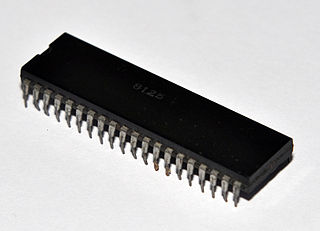
A field-programmable gate array (FPGA) is an integrated circuit designed to be configured by a customer or a designer after manufacturing – hence the term "field-programmable". The FPGA configuration is generally specified using a hardware description language (HDL), similar to that used for an application-specific integrated circuit (ASIC). Circuit diagrams were previously used to specify the configuration, but this is increasingly rare due to the advent of electronic design automation tools.

A programmable logic device (PLD) is an electronic component used to build reconfigurable digital circuits. Unlike integrated circuits (IC) which consist of logic gates and have a fixed function, a PLD has an undefined function at the time of manufacture. Before the PLD can be used in a circuit it must be programmed (reconfigured) by using a specialized program.

An application-specific integrated circuit is an integrated circuit (IC) chip customized for a particular use, rather than intended for general-purpose use. For example, a chip designed to run in a digital voice recorder or a high-efficiency bitcoin miner is an ASIC. Application-specific standard product (ASSP) chips are intermediate between ASICs and industry standard integrated circuits like the 7400 series or the 4000 series. ASIC chips are typically fabricated using metal-oxide-semiconductor (MOS) technology, as MOS integrated circuit chips.
Reconfigurable computing is a computer architecture combining some of the flexibility of software with the high performance of hardware by processing with very flexible high speed computing fabrics like field-programmable gate arrays (FPGAs). The principal difference when compared to using ordinary microprocessors is the ability to make substantial changes to the datapath itself in addition to the control flow. On the other hand, the main difference from custom hardware, i.e. application-specific integrated circuits (ASICs) is the possibility to adapt the hardware during runtime by "loading" a new circuit on the reconfigurable fabric.

Altera Corporation was a manufacturer of programmable logic devices (PLDs) headquartered in San Jose, California. On December 28, 2015, the company was acquired by Intel.

Programmable Array Logic (PAL) is a family of programmable logic device semiconductors used to implement logic functions in digital circuits introduced by Monolithic Memories, Inc. (MMI) in March 1978. MMI obtained a registered trademark on the term PAL for use in "Programmable Semiconductor Logic Circuits". The trademark is currently held by Lattice Semiconductor.

A gate array is an approach to the design and manufacture of application-specific integrated circuits (ASICs) using a prefabricated chip with components that are later interconnected into logic devices according to a custom order by adding metal interconnect layers in the factory.

A complex programmable logic device (CPLD) is a programmable logic device with complexity between that of PALs and FPGAs, and architectural features of both. The main building block of the CPLD is a macrocell, which contains logic implementing disjunctive normal form expressions and more specialized logic operations.

The Generic Array Logic device was an innovation of the PAL and was invented by Lattice Semiconductor. The GAL was an improvement on the PAL because one device type was able to take the place of many PAL device types or could even have functionality not covered by the original range of PAL devices. Its primary benefit, however, was that it was eraseable and re-programmable, making prototyping and design changes easier for engineers.
A soft microprocessor is a microprocessor core that can be wholly implemented using logic synthesis. It can be implemented via different semiconductor devices containing programmable logic, including both high-end and commodity variations.
The LatticeMico8 is an 8-bit microcontroller soft processor core optimized for field-programmable gate arrays (FPGAs) and crossover programmable logic device architecture from Lattice Semiconductor. Combining a full 18-bit wide instruction set with 32 general purpose registers, the LatticeMico8 is a flexible Verilog reference design suitable for a wide variety of markets, including communications, consumer, computer, medical, industrial, and automotive. The core consumes minimal device resources, less than 200 look up tables (LUTs) in the smallest configuration, while maintaining a broad feature set.
Flow to HDL tools and methods convert flow-based system design into a hardware description language (HDL) such as VHDL or Verilog. Typically this is a method of creating designs for field-programmable gate array, application-specific integrated circuit prototyping and digital signal processing (DSP) design. Flow-based system design is well-suited to field-programmable gate array design as it is easier to specify the innate parallelism of the architecture.
An electronic device or embedded system is said to be field-programmable or in-place programmable if its firmware can be modified "in the field," without disassembling the device or returning it to its manufacturer.
A simple programmable logic device (SPLD) is a programmable logic device with complexity below that of a complex programmable logic device (CPLD).

Tabula was an American fabless semiconductor company based in Santa Clara, California. Founded in 2003 by Steve Teig, it raised $215 million in venture funding. The company designed and built three dimensional field programmable gate arrays and ranked third on the Wall Street Journal's annual "Next Big Thing" list in 2012.
A field-programmable object array (FPOA) is a class of programmable logic device designed to be modified or programmed after manufacturing. They are designed to bridge the gap between ASIC and FPGA. They contain a grid of programmable silicon objects. Arrix range of FPOA contained three types of silicon objects: arithmetic logic units (ALUs), register files (RFs) and multiply-and-accumulate units (MACs). Both the objects and interconnects are programmable.
The Xputer is a design for a reconfigurable computer, proposed by computer scientist Reiner Hartenstein. Hartenstein uses various terms to describe the various innovations in the design, including config-ware, flow-ware, morph-ware, and "anti-machine".
Circuit underutilization also chip underutilization, programmable circuit underutilization, gate underutilization, logic block underutilization refers to a physical incomplete utility of semiconductor grade silicon on a standardized mass-produced circuit programmable chip, such as a gate array type ASIC, an FPGA, or a CPLD.
In computing, a logic block or configurable logic block (CLB) is a fundamental building block of field-programmable gate array (FPGA) technology. Logic blocks can be configured by the engineer to provide reconfigurable logic gates.
Verilog-to-Routing (VTR) is an open source CAD flow for FPGA devices. VTR's main purpose is to map a given circuit described in Verilog, a Hardware Description Language, on a given FPGA architecture for research and development purposes; the FPGA architecture targeted could be a novel architecture that a researcher wishes to explore, or it could be an existing commercial FPGA whose architecture has been captured in the VTR input format. The VTR project has many contributors, with lead collaborating universities being the University of Toronto, the University of New Brunswick, and the University of California, Berkeley. Additional contributors include Google, The University of Utah, Princeton University, Altera, Intel, Texas Instruments, and MIT Lincoln Lab.









